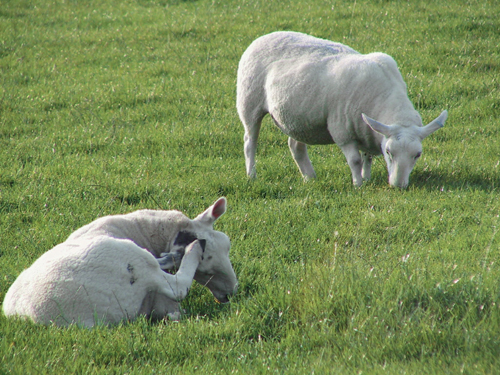Difference between revisions of "Sheep Medicine Q&A 08"
| (2 intermediate revisions by 2 users not shown) | |||
| Line 1: | Line 1: | ||
| − | {{Template:Manson | + | {{Template:Manson}} |
[[Image:Sheep Medicine 8.jpg|centre|500px]] | [[Image:Sheep Medicine 8.jpg|centre|500px]] | ||
| Line 15: | Line 15: | ||
They may stand with the head held lowered with frequent head shaking and ear movements. Alternatively, sheep adopt a submissive posture in sternal recumbency with the neck extended and the head held on the ground. Kicking at the head often greatly exacerbates damage caused by headflies to the horn base, and such action may also traumatize the skin of the neck and ears. Head rubbing also causes considerable self-trauma. <br><br> | They may stand with the head held lowered with frequent head shaking and ear movements. Alternatively, sheep adopt a submissive posture in sternal recumbency with the neck extended and the head held on the ground. Kicking at the head often greatly exacerbates damage caused by headflies to the horn base, and such action may also traumatize the skin of the neck and ears. Head rubbing also causes considerable self-trauma. <br><br> | ||
Bleeding and serum exudation attract more flies and aggravate the problem. There is rapid loss of condition in severely affected sheep. Myiasis may result in some cases. | Bleeding and serum exudation attract more flies and aggravate the problem. There is rapid loss of condition in severely affected sheep. Myiasis may result in some cases. | ||
| − | |l1= | + | |l1= |
|q2=How can this problem be controlled? | |q2=How can this problem be controlled? | ||
|a2= | |a2= | ||
| Line 21: | Line 21: | ||
*Topical emollients and antibiotic preparations are not usually necessary and skin wounds heal well provided flies are denied access to these areas. | *Topical emollients and antibiotic preparations are not usually necessary and skin wounds heal well provided flies are denied access to these areas. | ||
*Pour-on fly control preparations, such as high cis cypermethrin or deltamethrin, must be applied before the anticipated headfly season and especially to horned sheep. Such treatments should be repeated every 3–4 weeks during the fly season or as directed by the data sheet instructions. | *Pour-on fly control preparations, such as high cis cypermethrin or deltamethrin, must be applied before the anticipated headfly season and especially to horned sheep. Such treatments should be repeated every 3–4 weeks during the fly season or as directed by the data sheet instructions. | ||
| − | |l2= | + | |l2= |
</FlashCard> | </FlashCard> | ||
Revision as of 18:24, 12 April 2011
| This question was provided by Manson Publishing as part of the OVAL Project. See more [[:Category:{{{book}}}|{{{book}}}]]. |
In late summer a farmer complains that some ewes have lost considerable condition as a consequence of not grazing and are observed frequently kicking at their heads with their hindfeet, causing serious damage to the poll and ears. The affected ewes seem distressed, frequently running 10–15 m then stopping, only to start running away again.
| Question | Answer | Article | |
| What are possible causes of this problem? (Most likely cause first.) | Feeding around head wounds and ear tag injuries (and horn base) by the muscid fly Hydrotea irritans causes considerable irritation that frequently results in self-trauma. Grazing patterns are disturbed and affected sheep often isolate themselves and remain in shade where available. |
[[|Link to Article]] | |
| How can this problem be controlled? |
|
[[|Link to Article]] | |
